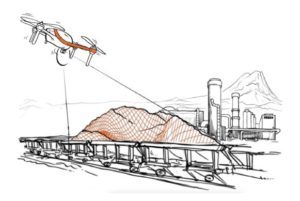
Israel Chemicals Ltd recently conducted a test to compare the accuracy of drone aerial surveys versus ground-based methods measuring several stockpiles of phosphate rock as a benchmark.
Using an end-to-end, fully automatic aerial survey solution from Israel-based drone firm Airobotics, ICL discovered that the 3D terrain models processed by the drone’s Correlator3D photometric software proved as accurate or more accurate than the more expensive, labor-intensive ground methods.
“I feel like this is the future. The Airobotics platform has provided us with a highly effective tool that is cheaper economically and saves us time,” ICL Executive Vice President (ICL Phosphate ) Yakov Kahlon said in a company statement.
“With the platform, we can measure in one day what once took multiple days to measure,” he added.
In addition to processing and detecting data faster, the Airobotics system has the ability to define surface features of any given stockpile of phosphate which may often obscured in ground-based methods.
Using ground-based methods, ICL has had to shut down site operations to conduct any surveys. By deploying an automated drone sensors system, the company would be able to conduct scheduled surveys with no operational interruptions.
“The resultant point cloud generated by Airobotics provided a higher resolution digital model without sacrificing the absolute accuracy obtained with alternative methods,” a company spokesperson said. “ICL has highlighted the significant operational benefits of the fully automated system, in which no drone setup, operation, or data processing is required.”
Several mining companies have already adopted drone survey systems. Last year, Rio Tinto, one of Australia’s largest mining and metal companies, struck a gold mine of new data by deploying UAVs. Also in 2015, Japanese equipment manufacturer Komatsu announced a partnership with Skycatch, a provider of commercial drone data solutions for mining companies.
Jason is a longstanding contributor to DroneLife with an avid interest in all things tech. He focuses on anti-drone technologies and the public safety sector; police, fire, and search and rescue.
Beginning his career as a journalist in 1996, Jason has since written and edited thousands of engaging news articles, blog posts, press releases and online content.
Email Jason
TWITTER:@JasonPReagan
Subscribe to DroneLife here.